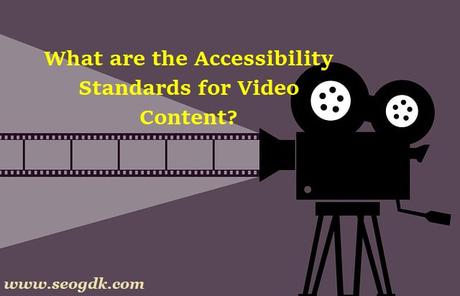

Videos are in every corner of the digital space in this digital world. Whether it be about entertaining or educating, they play an essential role in communicating with the audience. Nevertheless, not everyone might be able to adequately appreciate or get the content through video due to various accessibility limitations.
With that being said, this is where the video accessibility standards move into the spotlight. This post intends to explain to us what video accessibility entails, its importance, and the measures set to ensure that every member of the community can access and understand video content.
What is Video Accessibility?
Video accessibility in the digital world aims to make them usable for everyone, which includes people with special needs. They include persons with such conditions as hearing and speech impediments, blindness and visual impairments, or movement deficiencies.
By providing accessibility, users with different backgrounds, cultures, and capabilities can easily watch, understand, navigate the video, and interact with it without any obstacles.
What does Video Accessibility Mean for?
Think about it in this manner: the video without sound or captions (if you are hard of hearing or deaf) is what watching the video is like. For example not being able to tell what color a character has on or having no idea if you’re blind in case the video does not contain audio descriptions.
Here are only some of the barriers which are experienced by people, when they can’t understand the video information. Video accessibility is not only about keeping the established rules, it is about ensuring equal and aversive access for people with hearing impairments.
Understanding WCAG for Video Accessibility
The WCAG (Web Content Accessibility Guidelines) is a set of guidelines set by the W3C(World Wide Web Consortium), which is an international non-profit organization that develops web content accessibility standards to make web content more accessible for people with disabilities. WCAG deals with a variety of issues associated with the accessibility of videos.
Key WCAG Principles
Here are some key WCAG video accessibility principles that one should follow:
1. Perceivable:
Video content must be provided in formats, such as captions, accessible to all
users, irrespective of disability. In addition to these, closed captioning for
the hearing or hearing impaired users or audio description for the blind or
visually impaired users would be provided as well.
2. Operable:
The user side should let people deal with video content using several input
methods (namely keyboard or voice command). Engagement
in controls should be user-friendly and easy to interact with.
3. Understandable:
Video as well as text should be labeled clearly and devices' controls must be
easy to understand. Participants would enjoy watching and learning in more
interactive, engaging, and pleasurable ways. Communication should be comprised
of instructions, labels, and content that are understandable and not complex at
all.
4. Robust:
It is important that the video content will be usable with different assistive
technology including but not limited to captioning and subtitles, thus ensuring
that it can be used by its target users.
The Implementation of Accessibility Standards for Video Content
1. Captions
Captions are a written version of the audio information displayed in a video, running along with the video at the same time. They have become a valuable source of information for viewers who are hearing impaired or those viewers who watch the show in crowded places or in noisy environments where they cannot activate audio. Subtitles should be precise sound synchronized with synchronization and content coverage of all the spoken material as well as relevant sound, not speech.
2. Audio Descriptions
Audio description is a running commentary during videos. Audio description narrates visual cues like the actions of the characters, the settings, and the change of scenes. They supply the listeners with unavailable information, who might be seeing impaired or blind with the chosen information. Furthermore, auditory descriptions should be included by the dialogues, not the clues.
3. Player Accessibility
The video players must ensure that all elements are available for disabled users. This encompasses providing keyboard shortcuts to inflate controls, ensuring compatibility with the screen reader, and providing an easy option of adjusting volume and playback rate for users.
4. Color and Contrast
The use of conspicuous colors for videos is something that should make it easier for users who have inferior color vision to see things clearly. Another essential element should be to provide enough of a contrast between the text and background colors to facilitate the readability of the website to the benefit of users with low vision.
5. Sign Language Interpretation
Interpretation in sign language is helpful for videos that contain spoken content, which we can use to make these videos accessible for users for whom sign language is the primary method of communication.
The Role of Accessibility
Let’s take a closer look at how accessibility features benefit different user groups:
1. Deaf and Hard of Hearing User
Captions are life-savers for people who are debased or hard of hearing. It creates audio language which includes spoken talk, background noise, and other audio features that really make one understand the whole moving away. Moreover, captions go beyond helping with comprehension for these users as they are useful to users who are learning a new language, are experiencing a noisy environment, or have trouble with the accent.
2. Blind or Visually Impaired Users
Audio description is veritably the best means for the blind or persons with optical defects to understand the essence of a movie. This is done to develop well-elaborated narrations focusing on the visual elements, and these are immediately followed by actions, expressions, or scene changes, ensuring that the users can create a clear mental picture.
3. Older Adults
When people are elderly, they can experience a change in vision, hearing, or motor skills, which may make it a complicated task for them to get in touch with digital information. A set of accessibility features within the video that entails providing captions and adjustable playback speeds can create an incredible user experience for old people. Whilst we offer these features we make sure that the senior users can also continue to enjoy video content and remain connected in the tireless digital world of today.
How to Ensure Video Accessibility?
Doing the video content suitable for everyone is not difficult to achieve. Here are some practical steps you can take to ensure that your videos are accessible to everyone:
1. Add Subtitles and Audio Description
Include captions that are accurate by using subtitling programs. Ensure that captions are correctly aligned with the audio and contain all the spoken content and non-speech sound effects. If your video is based on visual elements, consider adding audio descriptions that will result in a complete hearing and seeing experience.
2. Selecting an Accessible Video Player
Pick a video player that supports accessibility features like keyboard shortcuts, screen reader compatibility, and adjustable controls. Test the player to ensure it’s free of glitches and has a user-friendly interface for all including those with assistive technologies.
3. Make Accessibility a Priority in the Design
When making video content, video accessibility should be taken into consideration starting from the onset. Make use of straightforward and simple language; refrain from using flashing lights or distracting visuals and provide sufficient color contrast between text and graphics. By designing the accessibility in your videos, you can create a platform that is easier for a wide range of people to understand and enjoy.
Key Takeaways
● Accessibility of the video makes sure that all people, notwithstanding disabilities, will be able to use and perceive video messages.
● The WCAG video accessibility standards outline a systematic process for the accessibility of video content.
● Captions convert audio material to text for the use of people with hearing loss.
● Audio descriptions are a means of providing vision for the blind or visually impaired audience.
● Player accessibility affirms that video players are helpful to people with disabilities.
● The right of colors and contrasts facilitate readability for users with low vision.
Conclusion
Video accessibility makes videography accessible to users who only use sign language language. Apart from facilitating access to videos for people with special needs, proximity to these videos also heightens the efficiency for all users.
The adoption of accessibility standards can lead to a more equitable digital space where people, irrespective of physical disabilities, have the same opportunity to access and enjoy online content.

This post was proofread by Grammarly

